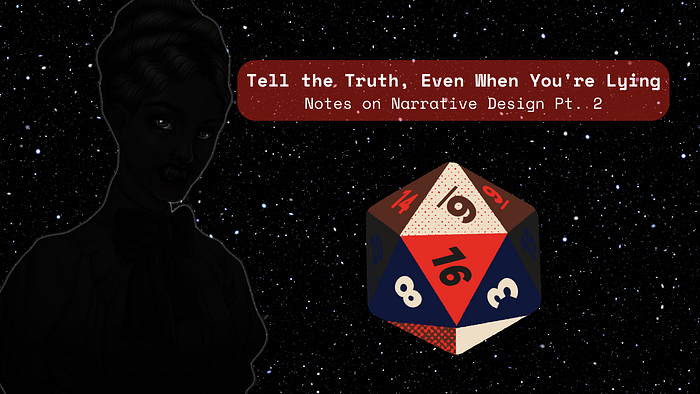Tell the Truth, Even When You’re Lying, Part 2.
Notes on Narrative Design by Dan Tabayoyon, Lead Narrative Designer, Blood Vessels, Kongregate. You can find Part 1 here!

I’d argue with most narrative design, the task of creating a narrative seems simple enough on the surface: You have an idea. You work to build a world or setting creating characters to live in that world, and create reasons the player experience matches the mechanics you’re introducing to the player. You build lore and story that makes sense for the framework of the game.
As a designer, I always start with the story first when introducing a new player to a game.
We’re all powerful magic users who cast spells to summon creatures, enchantments, and artifacts to defeat other magic users who travel the planar multiverse.
We’re all space truckers, carrying long haul supplies for the Company while avoiding pirates, meteor showers, and the catastrophic failure of our derelict ships.
We’re time travelers moving between past, present, and future, trying to outwit each other so only one of us remains.
Ideation, creation, editing, grammar-checking, language use, plot, theme, character, etc — all of this is the work of narrative design. Creating that world and then making it make sense is all part of the design process.
You also gotta put the words in the right places and stuff.
But none of those tools is more important to the work of narrative design than research.
Research is part of storytelling as much as the mechanical part of writing. Without that solid foundation in the “real”, the fiction ultimately suffers.
Listen… Not every game you make is going to require this kind of level of detailed study in history. You can tailor your work to the needs of your game when appropriate. Maybe the story of Candy Crush is that you crush the candies. That seems to work just fine.
What’s the central theme behind Solitaire? Person plays cards alone. Yeah, you probably don’t need a deep dive there.
But in the right context — say, if you’re writing a story about the creator of Solitaire and how the game developed, for example — then you might need to spend some time digging around.
(Fun fact: It was a French aristocrat imprisoned in the Bastille by King Louis XIV during the first half of the 17th century, by the way. You’re welcome.)
Not everyone is like me, pointing at street signs in movies saying, “That’s not where that goes!” But…
When something untrue is noticeable to the people paying attention — even subconsciously — then it detracts. It pulls focus. It closes the loop on audience engagement, which is a big no-no, especially in games.
When a story misses a detail or a setting misses its historical place or a character uses technology that doesn’t exist in the time frame of the story — it’s not just glaringly bad. It’s unforgivable.
Those kinds of mistakes are a stop sign in the middle of an empty field: a curiosity; a road bump; an eject button. It takes the audience out of the flow and stops them from engaging. It makes them question everything instead of doing the most important thing you want from them:
It causes them to stop listening to your story.
In the world of storytelling that, Dear Friends, is death. You might as well pack it in and call it a day if that happens. Because you’re telling your audience — your players — that nothing they’re doing matters. They might as well go watch Netflix or scroll through TikToks for the rest of the evening. Anything else that might garner their attention more than whatever it is your game is supposed to do for them.
Respect your audience — and their attention — by doing the work.
If a good story is just a lie told well, then Narrative Designers are, by virtue or vice, the caretakers of that lie. To tell it well, we need to be as truthful as possible.
If the goal of good storytelling is engagement and immersion, then don’t give your audience a reason to get distracted by the little things that are out of place. Trust me, they’ll find them, even if you don’t think they’ll go looking for them. Heck, especially if you don’t think they will.
When working on narrative design for your game — no matter how real or fictional — it’s always a best practice to treat your audience like they’re the experts. Then reward them for being smarter than you.
Because they are.
Fun fact.
*If you’d like to learn more about Blood Vessels & narrative design, join us October 6th at 12:45pm PST for the 2nd episode of our Blood Vessels livestream series here!